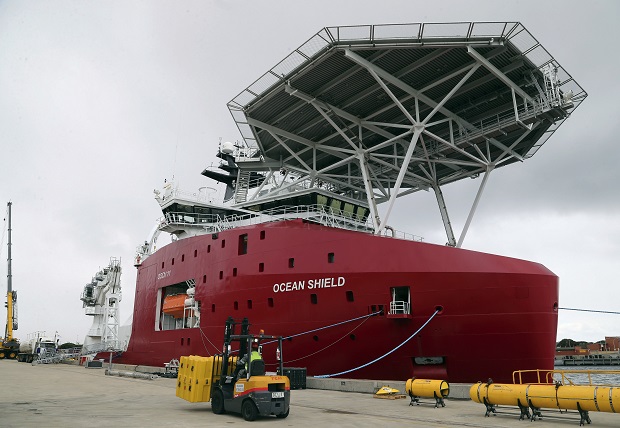Jet searchers rule out area where ‘pings’ heard

Australian Defense ship Ocean Shield is docked at naval base HMAS Stirling while being fitted with an autonomous underwater vehicle (AUV) and towed pinger locator to aid in the search for missing Malaysia Airlines Flight MH370, Sunday, March 30, 2014, in Perth, Australia. It will still take three to four days for the ship to reach the search zone — an area roughly the size of Poland about 1,850 kilometers (1,150 miles) to the west of Australia. AP
CANBERRA — Investigators searching for the missing Malaysian jet have ruled out an area where acoustic signals were detected as the final resting place of the plane after an unmanned submersible found no trace of it, the Australian agency coordinating the hunt said Thursday.
The U.S. Navy’s Bluefin 21 had finished its final underwater mission in the southern Indian Ocean on Wednesday after scouring 850 square kilometers (330 square miles), the Joint Agency Coordination Center said.
“The area can now be discounted as the final resting place” of the missing plane, the center said in a statement.
The underwater search for the airliner, which vanished March 8 with 239 people on board en route from Kuala Lumpur to Beijing, will be suspended for a couple months until while new, more powerful sonar equipment is brought in to search a much wider area of 56,000 square kilometers (21,600 sq. miles), based on analysis of satellite data of the plane’s most likely course, the center said.
That analysis has led authorities to believe that Malaysia Airlines Flight 370 diverted sharply from its flight path and flew south to the Indian Ocean. But not a single piece of the missing Boeing 777 has been found in one of aviation’s most baffling mysteries.
Article continues after this advertisementThe news comes after the U.S. Navy on Thursday dismissed an American expert’s reported comments that acoustic “pings” heard in April did not come from the jet’s black boxes.
Article continues after this advertisementCNN reported that the Navy’s civilian deputy director of ocean engineering, Michael Dean, said most countries now agreed that the sounds detected by the Navy’s Towed Pinger Locator came from a man-made source unrelated to the jet.
“Mike Dean’s comments today were speculative and premature, as we continue to work with our partners to more thoroughly understand the data acquired by the Towed Pinger Locator,” U.S.
Navy spokesman Chris Johnson said in a statement, referring to Australia and Malaysia.
Dean, who is based in Washington, could not be immediately reached for comment.
The joint coordination agency declined to comment on the report. It said it would not yet reveal the next most likely crash site, saying that “will be made public in due course.”
Officials had described the detection of four series of “pings” in the area that the satellite data indicated was the likely crash site as their best lead in the search. The signals appeared to be consistent with those from aircraft black boxes, which contain flight data and cockpit voice recordings. The locator beacons have a battery life of about a month, so it is presumed they have died.
Earlier this week, the Malaysian government released reams of raw satellite data it used to determine that the flight ended in the southern Indian Ocean, a step long demanded by the families of some of the passengers on board. The conclusion is based on complex calculations derived largely from brief hourly transmissions, or “handshakes,” between the plane and a communications satellite operated by the British company Inmarsat.
But while the 45 pages of information may help satisfy a desire for more transparency in a much criticized investigation, experts say it’s unlikely to solve the mystery of Flight 370. Theories range from mechanical failure to hijacking or pilot murder-suicide.
The families of the victims — many of whom have been highly critical of the Malaysian government and, in the absence of any wreckage, have been unwilling to accept that their loved ones are dead — had been asking for the raw satellite data for many weeks so it could be examined by independent experts. Malaysia initially balked at doing so, but then reconsidered.
RELATED STORIES
MH370 remains a mystery as Malaysia releases report